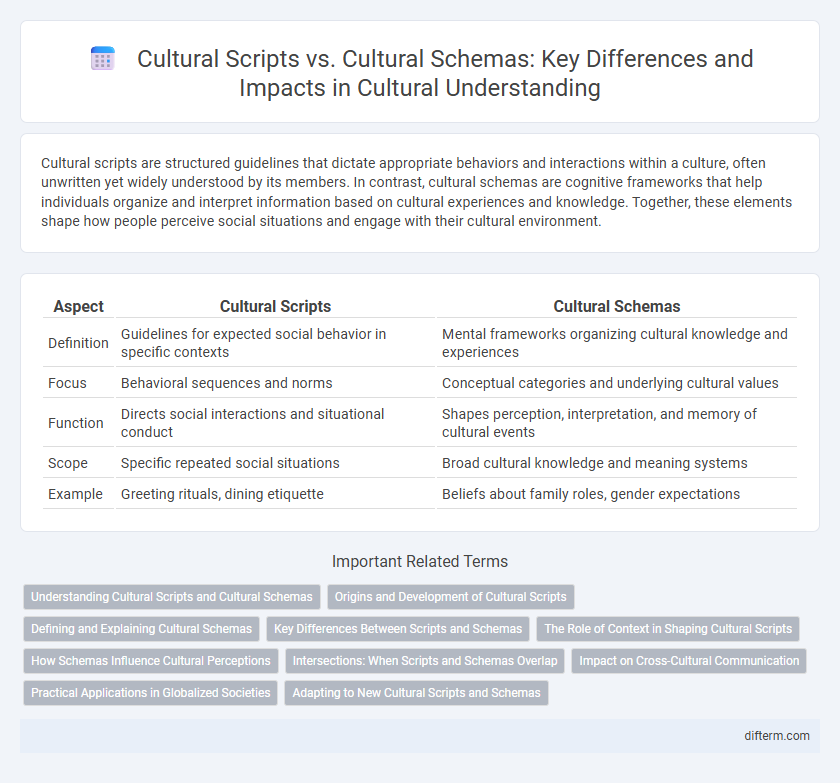Cultural scripts are structured guidelines that dictate appropriate behaviors and interactions within a culture, often unwritten yet widely understood by its members. In contrast, cultural schemas are cognitive frameworks that help individuals organize and interpret information based on cultural experiences and knowledge. Together, these elements shape how people perceive social situations and engage with their cultural environment.
Table of Comparison
| Aspect | Cultural Scripts | Cultural Schemas |
|---|---|---|
| Definition | Guidelines for expected social behavior in specific contexts | Mental frameworks organizing cultural knowledge and experiences |
| Focus | Behavioral sequences and norms | Conceptual categories and underlying cultural values |
| Function | Directs social interactions and situational conduct | Shapes perception, interpretation, and memory of cultural events |
| Scope | Specific repeated social situations | Broad cultural knowledge and meaning systems |
| Example | Greeting rituals, dining etiquette | Beliefs about family roles, gender expectations |
Understanding Cultural Scripts and Cultural Schemas
Cultural scripts refer to the socially learned, shared patterns of behavior and communication that guide individuals in specific social contexts, often dictating how people should act, speak, and interact within a culture. Cultural schemas, on the other hand, are cognitive structures that organize knowledge and expectations about cultural norms, values, and roles, influencing perception and interpretation of social situations. Understanding cultural scripts involves recognizing explicit behavioral guidelines, while grasping cultural schemas requires insight into deeper mental frameworks shaping cultural understanding and identity.
Origins and Development of Cultural Scripts
Cultural scripts originate from repeated social interactions and shared practices within a community, shaping implicit behavioral guidelines that evolve over time through communication and cultural transmission. Unlike cultural schemas, which are broader cognitive structures encompassing knowledge and beliefs about a culture, cultural scripts specifically regulate situational behaviors and expectations in social contexts. The development of cultural scripts is influenced by historical events, linguistic patterns, and social norms that collectively encode community-specific ways of interpreting and responding to everyday situations.
Defining and Explaining Cultural Schemas
Cultural schemas are cognitive frameworks that help individuals organize and interpret information based on shared cultural knowledge and experiences. They shape behavior, expectations, and communication patterns by providing mental shortcuts for understanding social situations within a specific culture. Unlike cultural scripts that outline expected sequences of behavior, cultural schemas encompass broader, deeply ingrained patterns influencing perception and decision-making.
Key Differences Between Scripts and Schemas
Cultural scripts refer to predefined, sequential behaviors and communication patterns shared within a culture, guiding how individuals interact in specific social contexts. Cultural schemas are broader cognitive frameworks that organize knowledge, beliefs, and expectations about cultural phenomena, shaping interpretation and meaning-making. The key difference lies in scripts emphasizing procedural actions in social situations, while schemas encompass general mental representations influencing perception and understanding.
The Role of Context in Shaping Cultural Scripts
Cultural scripts are structured frameworks guiding behavior and communication within specific social contexts, shaped profoundly by situational cues and environmental factors. Cultural schemas represent broader mental models that store generalized knowledge about cultural norms, but the context determines how these schemas activate relevant cultural scripts in real-time interactions. Understanding the dynamic interplay between context and cultural scripts reveals how individuals navigate social expectations and adapt behaviors across diverse cultural settings.
How Schemas Influence Cultural Perceptions
Cultural schemas shape how individuals interpret social cues by providing mental frameworks that organize experiences and expectations within a culture. These schemas influence cultural perceptions by filtering information through established patterns, leading to variations in communication styles, values, and behaviors across different societies. Understanding cultural schemas enables better intercultural competence by highlighting the subconscious scripts that guide perception and interactions.
Intersections: When Scripts and Schemas Overlap
Cultural scripts and cultural schemas intersect in guiding behavior by providing both specific sequences of actions and overarching frameworks for interpreting social situations. For example, a cultural script for a wedding ceremony outlines expected behaviors and rituals, while the cultural schema shapes the broader understanding of marriage and community roles. This overlap enables individuals to navigate complex social interactions with shared expectations, reinforcing cultural continuity and identity.
Impact on Cross-Cultural Communication
Cultural scripts provide detailed, context-specific guidelines for behavior and communication in social interactions, influencing how messages are constructed and interpreted across cultures. Cultural schemas represent broader cognitive frameworks that shape individuals' expectations and understanding of social roles and norms, affecting perception and interaction patterns in cross-cultural settings. Misalignments between cultural scripts and schemas can lead to miscommunication, misunderstandings, and reduced effectiveness in international communication and collaboration.
Practical Applications in Globalized Societies
Cultural scripts define expected behaviors and communication patterns within a society, guiding interactions in multicultural environments and facilitating cross-cultural understanding. Cultural schemas, as mental frameworks, help individuals interpret experiences and navigate unfamiliar cultural contexts by shaping perceptions and responses. Practical applications in globalized societies include improving international business negotiations, enhancing intercultural training programs, and fostering effective collaboration across diverse teams.
Adapting to New Cultural Scripts and Schemas
Adapting to new cultural scripts requires understanding specific behavioral patterns and communication styles embedded in social contexts, while adjusting to cultural schemas involves reshaping broader cognitive frameworks that influence perceptions and social norms. Successful cultural adaptation depends on the flexible integration of both dynamic scripts and stable schemas to navigate unfamiliar cultural environments effectively. Cognitive flexibility and intercultural competence enhance the ability to internalize new cultural scripts and modify existing schemas, facilitating smoother cross-cultural interactions.
Cultural scripts vs Cultural schemas Infographic

 difterm.com
difterm.com